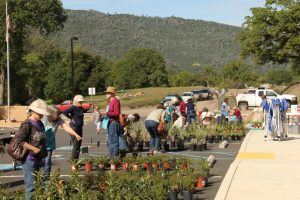Gardening With Native Plants
There are over 6000 native plant species in California, some of which are nowhere else in the world. Roughly half of those are suitable for gardens. Many native plants from one region of California can be grown in another, but local native communities are the best places to look for inspiration and potential plant choices. Knowing the dominant plant community in your area will help you understand what plants naturally grow well there.
The key to successful native gardening is matching their natural growing conditions to your site. While many are drought tolerant, plants that naturally grow in shady streambeds will have different needs from chaparral plants that naturally occur in dry, sunny, exposed sites. The same applies to plants that have frost intolerances that grow well in Southern California or mild winter areas, but are not good choices for planting in areas with hard freezes. Most natives need good drainage and benefit when planted on mounds or in raised beds. All need water to get established, some may need occasional deep watering the first or second year, or longer. The best time to plant natives is in the fall or winter, as the winter rains encourage the deep roots natives need to survive during the long summer droughts. Native plants should not be fertilized, and heavy mulching is not necessary. Allow leaf litter to accumulate under native trees and shrubs, just as it would in natural conditions.
There are many native perennials such as asters, mints, California fuchsias, that flower all summer, but the glory season for California native plants is the spring. The native spring starts in late winter and extends well into summer. Then, in the fall when the same trees and shrubs are no longer blooming, they are feeding birds and other creatures with nuts, berries, seeds and fruit. Summer is not the time to water naturally dormant plants.
A wildlife habitat garden does not have to be composed of all native plants. Including compatible non-native food and nectar plants that bloom and set fruit in different seasons can both supplement peak bloom times of native plants and prolong spring flowering through the summer months when bees, butterflies, pollinators and beneficial insects are foraging.
Summer blooming non-natives from the mint family (such as sages, lavender, calamint, catmint, lemon balm, thyme) and the sunflower family (asters, cosmos, zinnias, coreopsis, blanket flower) are good sources of nectar and pollen. Plants from these two families also include many California natives. They are excellent for inclusion into the native garden as they flower over very long periods and the seeds from the composite flowers provide food into the fall and winter for finches, juncos, and other seed-eating birds. Choose the single-flowered, old-fashioned plant varieties, such as sunflowers, zinnias, cone flowers, black-eyed Susan, and marigolds as they are more nectar and pollen rich than the over-hybridized versions. Flowers from medicinal and culinary herbs – rosemary, oregano and dill – are excellent nectar sources for all types of pollinators. Butterflies and bees flock to the flowers of strawberry tree (Arbutus unedo) and the broad pinkish tops of Sedum ’Autumn Joy’ in late summer. Red hot poker plant, bottlebrush, flowering maple (Abutilon spp.), and fuchsias are valuable plants for the hummingbird garden.
There are endless non-native food and nectar plant species available and compatible with our climate and with California natives. Grow a diversity of plants, with an emphasis on natives that bloom at different times of the year.
Enjoy your native garden!
Wendy Weidenman is a University of California Cooperative Extension Master Gardener of Tuolumne County.
UCCE Master Gardeners of Tuolumne County can answer home gardening questions. Call 209-533-5912 or go to: http://ucanr.edu/survey/survey.cfm?surveynumber=7269 to fill out our easy-to-use problem questionnaire. Check out our website at: http://cecentralsierra.ucanr.edu/Master_Gardeners/ You can also find us on Facebook or pick up the local UCCE Master Gardener book “Sharing the Knowledge: Gardening in the Mother Lode” at Mountain Books or the UCCE Office both in Sonora, CA

